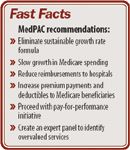Article
MedPAC to Congress: Drop SGR, increase payments
Washington--Congress has received a detailed recommendation from the Medicare Payment Advisory Commission (MedPAC) that would result in an average payment increase of an estimated 2.8% for next year, rather than continued cuts as projected by Medicare.

The recommendation was contained in the 2006 Medicare Payment Policy Report to Congress by MedPAC, an independent congressional advisory body. The report also urges elimination of the controversial sustainable growth rate (SGR) formula, which is responsible for the recommended fee reductions through 2011 and which has been called "unsustainable" by AUA.
In addition, MedPAC warned that policymakers must immediately act to slow Medicare spending growth and to encourage greater efficiency from health care providers. Thus, the commission urged policymakers to establish a pay-for-performance policy that would serve to increase provider efficiency.

Strategies to achieve that goal include cutting provider payments, reducing benefits, increasing program financing, and encouraging greater efficiency, it added.
"The last strategy-increasing efficiency-is the most desirable because it would enable the Medicare program to do more with its resources," MedPAC said while cautioning that even with such a policy in place, other actions may be needed to solidify the Medicare program for the future.
Planning for 2007
Regarding payment levels for 2007, MedPAC recommended that Congress update payments by the projected change in "input prices," the cost of providing service minus the commission's established goal of increasing productivity by 0.9% for 2007. CMS has projected that input prices will increase by 3.7%; thus, the net increase would be 2.8%.
The commission's recommendation followed enactment of the Deficit Reduction Act of 2005 in January 2006 that wiped out a projected 4.4% reduction in overall Medicare payment levels for 2006.
"Although the recent Deficit Reduction Act overrode the cut that the SGR called for in 2006, it does not address payment levels for 2007, the year for which we are making our recommendation, and beyond," MedPAC pointed out. "Under current law, the SGR continues to call for substantial negative updates for 2007 through 2011.
"The commission does not support these impending fee cuts. We are concerned that such consecutive annual cuts would threaten access to physician services over time, particularly primary care services."
The commission's report supported what amounts to an $8 billion reduction in reimbursement to hospitals, as well as increases in premiums and deductibles for Medicare beneficiaries. By law, the monthly premium for Medicare Part B must cover 25% of the program's costs.
MedPAC Chairman Glenn M. Hackbarth, in testimony before the House Ways and Means Health Subcommittee on March 1, 2006, said Medicare payment rates to health care providers should be set so the government benefits from productivity gains the same as "private purchasers of goods in competitive markets benefit from the productivity gains of their suppliers."
"In developing its payment recommendations, MedPAC expects improvements in productivity consistent with the productivity gains achieved by the firms and workers who pay the taxes and premiums that support Medicare," Hackbarth said.
While Medicare already has some programs in place to improve quality, the effort needs to be system-wide, Hackbarth emphasized.
"Medicare should start differentiating among providers by paying more for higher-quality performance and less for poor quality," he declared. "This change to Medicare's payment systems is urgently needed."
Congress, he said, should direct the agency to set quality standards for all providers who bill Medicare for performing and interpreting diagnostic imaging studies.





